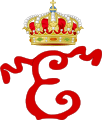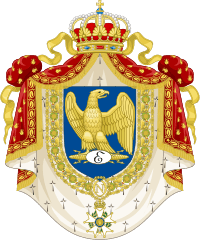Eugène de Beauharnais
| Eugène de Beauharnais | |||||
|---|---|---|---|---|---|
|
French Prince Prince of Venice Grand Duke of Frankfurt | |||||
 Eugène de Beauharnais, portrait by Andrea Appiani, 1810. | |||||
| Viceroy of Italy | |||||
| Term | 5 June 1805 – 11 April 1814 | ||||
| Monarch | Napoleon I | ||||
| Duke of Leuchtenberg Prince of Eichstätt | |||||
| Tenure | 14 November 1817 – 21 February 1824 | ||||
| Successor | Auguste de Beauharnais | ||||
| Born |
3 September 1781 Paris, France | ||||
| Died |
21 February 1824 (aged 42) Munich, Bavaria | ||||
| Burial | St. Michael's Church, Munich | ||||
| Spouse | Princess Augusta of Bavaria | ||||
| Issue |
Josephine, Queen of Sweden Eugénie, Princess of Hohenzollern-Hechingen Auguste, 2nd Duke of Leuchtenberg Amélie, Empress of Brazil Théodoline, Countess Wilhelm of Württemberg Princess Carolina Maximilian, 3rd Duke of Leuchtenberg | ||||
| |||||
| House | Beauharnais | ||||
| Father | Alexandre de Beauharnais | ||||
| Mother | Joséphine Tascher de la Pagerie | ||||
| Religion | Roman Catholicism | ||||
Eugène Rose de Beauharnais (3 September 1781 – 21 February 1824) was the first child and only son of Alexandre de Beauharnais and Joséphine Tascher de la Pagerie, first wife of Napoleon I.
He was born in Paris, France, and became the stepson and adopted child (but not the heir to the imperial throne) of Napoleon I. His biological father was executed during the revolutionary Reign of Terror. He commanded the Army of Italy and was Viceroy of Italy under his stepfather.
Historians have looked upon him as one of the ablest of Napoleon's relatives.[1]
Military career
Eugène's first campaign was in the Vendée, where he fought at Quiberon. However, within a year his mother Joséphine had arranged his return to Paris. In the Italian campaigns of 1796–1797, Eugène served as aide-de-camp to his stepfather, whom he also accompanied to Egypt. In Egypt, Eugène was wounded during the Siege of Acre (1799). He returned to France in the autumn of 1799 and helped bring about the reconciliation between Bonaparte and his mother, who had become estranged due to the extramarital affairs of both. When Napoleon became First Consul, Eugène became a captain in the Chasseurs à Cheval of the Consular Guard. With his squadron he took part in the Battle of Marengo.
During the War of the Fifth Coalition, Eugène was put in command of the Army of Italy, with General Étienne-Jacques-Joseph-Alexandre MacDonald as his military advisor. In April 1809 he fought and lost the Battle of Sacile against the Austrian army of the Archduke John, but Eugène's troops decisively won the rematch at the Battle of the Piave in May and the Battle of Raab in June. After the Battle of Aspern-Essling, Napoleon recalled the Army of Italy to Austria. After joining the main army on the island of Lobau in the Danube, Eugène took part in the Battle of Wagram.
During the Russian campaign, Eugène again commanded the Army of Italy (IV Corps) with which he fought in the Battle of Borodino and the Battle of Maloyaroslavets. After Napoleon and then Joachim Murat had left the retreating army, Eugène took command of the remnants and led it back to Germany in 1813.
During the campaign of 1813, Eugène fought in the Battle of Lützen. Napoleon then sent him back to Italy, where he organised the defence against the Austrians, holding out on the Mincio until the abdication in 1814. After the fall of Napoleon in 1814, Eugène retired to Munich and at the behest of his father-in-law King Maximilian of Bavaria, did not get involved with Napoleon and France again.
Status and titles
On 14 June 1804 he was made an official member of the imperial family as His Imperial Highness, French Prince (Prince français) Eugène de Beauharnais. By a statute of 5 June 1805 the Emperor added Viceroy of Italy to his titles.
Eugène was adopted by Napoleon on 12 January 1806, though excluded from succession to the French Empire. On 16 February 1806, Eugène was declared heir presumptive to the Kingdom of Italy, in the absence of a second son of Napoleon. On 20 December 1807 he was given the title of Prince de Venise ("Prince of Venice"), a title created on 30 March 1806, when the Venetian Province taken from Austria in 1805 was united to Bonaparte's Kingdom of Italy.
In 1810, Napoleon used his influence over Karl von Dalberg, Archbishop of Regensburg and Grand Duke of Frankfurt, to name Eugène as constitutional heir of the grand duchy. Von Dalberg abdicated on 26 October 1813 due to Frankfurt's imminent conquest by the allied armies, and Eugène succeeded to the throne until Frankfurt was occupied by the allies in December of that same year.
A further imperial sinecure was Archichancelier d'État de l'Empire de France ("Archchancellor of State of the Empire of France").
He was an active Freemason and was involved in setting up the Grand Orient of Italy and its Supreme Council.[2]
Heraldry
-

Monogram of Eugène de Beauharnais
-

Coat of arms as
French Prince -

Coat of arms as
Viceroy of Italy -
.svg.png)
Coat of arms as
Duke of Leuchtenberg
Family
On 14 January 1806, two days after his adoption by Napoleon, Eugène married Princess Augusta Amalia Ludovika Georgia of Bavaria (1788–1851), eldest daughter of Napoleon's ally, King Maximilian I Joseph of Bavaria. On 14 November 1817, his father-in-law made him Duke of Leuchtenberg and Prince of Eichstätt.
Eugène and Augusta had seven children:
- Princess Joséphine Maximiliane Eugénie Napoléonne de Beauharnais (1807–1876); became the Queen Consort to King Oscar I of Sweden, himself the son of Napoleon's old love, Désirée Clary.
- Princess Eugénie Hortense Auguste de Beauharnais (1808–1847); married Friedrich, Prince of Hohenzollern-Hechingen.
- Prince Auguste Charles Eugène Napoléon de Beauharnais, 2nd Duke of Leuchtenberg (1810–1835); married Queen Maria II of Portugal. There was no issue from this marriage.
- Princess Amélie Auguste Eugénie Napoléone de Beauharnais (31 July 1812 – 26 January 1873); was the second wife of Pedro I of Brazil (father of Maria II of Portugal) and became Empress of Brazil.
- Princess Theodelinde Louise Eugénie Auguste Napoléone de Beauharnais (1814–1857); married Wilhelm, 1st Duke of Urach.
- Princess Carolina Clotilde de Beauharnais (1816)
- Prince Maximilian Josèphe Eugène Auguste Napoléon de Beauharnais (1817–1852); married Grand Duchess Maria Nikolaievna of Russia, eldest daughter of Tsar Nicholas I of Russia, and received the title of "Prince Romanovsky", addressed as "His Imperial Highness", in 1852.
Eugène de Beauharnais died on 21 February 1824 in Munich.
A biography by Carola Oman, Napoleon's viceroy, Eugène de Beauharnais, appeared in 1966.
Ancestry
| Ancestors of Eugène de Beauharnais | ||||||||||||||||||||||||||||||||||||||||||||||||||||||||||||||||||||||||||||||||||||||||||||||||||||||||||||||||||||||||||||||||||||||||||||||||||||||||||||||||||||||||||||||||||||||||||||||||||||||||||||||||||||||||||||||||||||||||||||||||||||||||||||||||||||||||||||||||||||||||||||||||||||||||||||||||||||||||||||||||||||||||||||||||||||||||||||||||||||||||||||||||||||||||||||||||||||||||||||||||||||||||||||||||||||||||||||||||||||||||||||||||||||||||||||||||||||||||||||||||||||||||||||||||||||||||||||||||||
|---|---|---|---|---|---|---|---|---|---|---|---|---|---|---|---|---|---|---|---|---|---|---|---|---|---|---|---|---|---|---|---|---|---|---|---|---|---|---|---|---|---|---|---|---|---|---|---|---|---|---|---|---|---|---|---|---|---|---|---|---|---|---|---|---|---|---|---|---|---|---|---|---|---|---|---|---|---|---|---|---|---|---|---|---|---|---|---|---|---|---|---|---|---|---|---|---|---|---|---|---|---|---|---|---|---|---|---|---|---|---|---|---|---|---|---|---|---|---|---|---|---|---|---|---|---|---|---|---|---|---|---|---|---|---|---|---|---|---|---|---|---|---|---|---|---|---|---|---|---|---|---|---|---|---|---|---|---|---|---|---|---|---|---|---|---|---|---|---|---|---|---|---|---|---|---|---|---|---|---|---|---|---|---|---|---|---|---|---|---|---|---|---|---|---|---|---|---|---|---|---|---|---|---|---|---|---|---|---|---|---|---|---|---|---|---|---|---|---|---|---|---|---|---|---|---|---|---|---|---|---|---|---|---|---|---|---|---|---|---|---|---|---|---|---|---|---|---|---|---|---|---|---|---|---|---|---|---|---|---|---|---|---|---|---|---|---|---|---|---|---|---|---|---|---|---|---|---|---|---|---|---|---|---|---|---|---|---|---|---|---|---|---|---|---|---|---|---|---|---|---|---|---|---|---|---|---|---|---|---|---|---|---|---|---|---|---|---|---|---|---|---|---|---|---|---|---|---|---|---|---|---|---|---|---|---|---|---|---|---|---|---|---|---|---|---|---|---|---|---|---|---|---|---|---|---|---|---|---|---|---|---|---|---|---|---|---|---|---|---|---|---|---|---|---|---|---|---|---|---|---|---|---|---|---|---|---|---|---|---|---|---|---|---|---|---|---|---|---|---|---|---|---|---|---|---|---|---|---|---|---|---|---|---|---|---|---|---|---|---|---|---|---|---|---|---|---|---|---|---|---|---|---|---|---|---|---|---|---|---|---|---|---|---|---|---|---|---|---|---|---|---|---|---|---|---|---|---|---|---|---|---|---|---|---|---|---|---|---|---|---|---|---|---|---|---|---|---|---|---|---|---|---|---|---|---|---|---|---|---|---|---|---|---|---|---|---|---|---|---|---|---|---|---|---|---|---|---|---|---|---|---|---|---|---|
| ||||||||||||||||||||||||||||||||||||||||||||||||||||||||||||||||||||||||||||||||||||||||||||||||||||||||||||||||||||||||||||||||||||||||||||||||||||||||||||||||||||||||||||||||||||||||||||||||||||||||||||||||||||||||||||||||||||||||||||||||||||||||||||||||||||||||||||||||||||||||||||||||||||||||||||||||||||||||||||||||||||||||||||||||||||||||||||||||||||||||||||||||||||||||||||||||||||||||||||||||||||||||||||||||||||||||||||||||||||||||||||||||||||||||||||||||||||||||||||||||||||||||||||||||||||||||||||||||||
References
- Citations
- ↑ Caulaincourt 1933, p. 403.
- ↑ le Premier Empire
- Bibliography
- Caulaincourt, Armand-Augustin-Louis With Napoleon in Russia translated by Jean Hanoteau New York, Morrow 1935.
- Oman, Carola Napoleon's viceroy, Eugène de Beauharnais London: Hodder & Stoughton, 1966.
External links
| Wikimedia Commons has media related to Eugène de Beauharnais. |
- Napoleon & Empire La franc-maçonnerie sous le Consulat et le Premier Empire (French)
- Genealogy of the Ducal Family of Leuchtenberg at the Wayback Machine (archived October 28, 2009)
- Heraldica.org - Napoleonic titles outside France
 Chisholm, Hugh, ed. (1911). "Beauharnais, Eugène de". Encyclopædia Britannica (11th ed.). Cambridge University Press.
Chisholm, Hugh, ed. (1911). "Beauharnais, Eugène de". Encyclopædia Britannica (11th ed.). Cambridge University Press. Beach, Chandler B., ed. (1914). "Beauharnais, Eugène de". The New Student's Reference Work. Chicago: F. E. Compton and Co.
Beach, Chandler B., ed. (1914). "Beauharnais, Eugène de". The New Student's Reference Work. Chicago: F. E. Compton and Co.
| Eugène de Beauharnais Born: 3 September 1781 Died: 21 February 1824 | ||
| Political offices | ||
|---|---|---|
| Preceded by Office created |
Viceroy of Italy 5 June 1805 – 11 April 1814 |
Succeeded by Office abolished |
| Italian royalty | ||
| Preceded by Title created |
Heir to the Italian throne as Prince of Venice 20 December 1807 – 11 April 1814 |
Vacant Title next held by Umberto Rainieras Prince of Piedmont |
| German nobility | ||
| Title(s) created | Duke of Leuchtenberg 14 November 1817 – 21 February 1824 |
Succeeded by Auguste de Beauharnais |
| Prince of Eichstätt 14 November 1817 – 21 February 1824 | ||
| ||||||||||||||||||||||||||||||||||||||||||||||
| |||||||||||||||||
| ||||||||||||||||||||||||||||||||||||
|
2.svg.png)